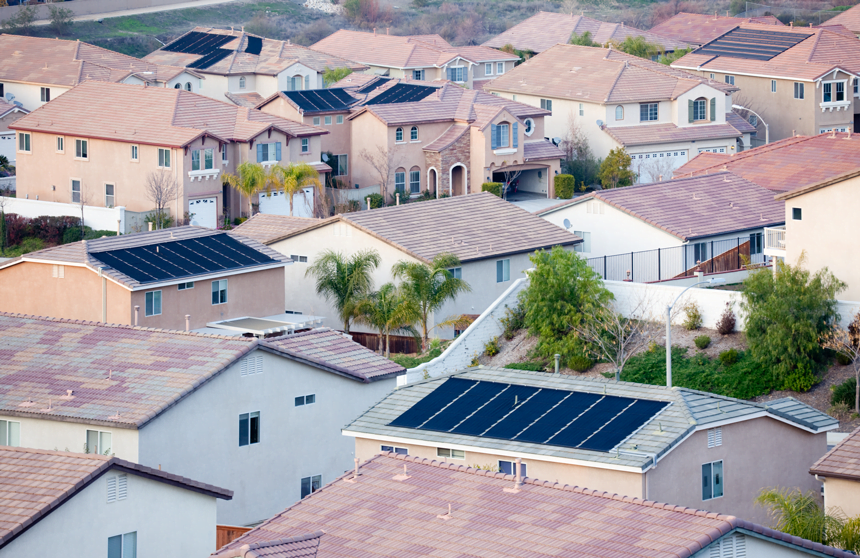A prior version of this article stated “one kilowatt is equal to one million watts.” This has been corrected to state “one megawatt is equal to one million watts.”
Are pre-installed rooftop solar panels really included as homebuilders advertise — or are they something extra altogether?
The allure is straightforward: the homebuyer is acquiring a new house, built to the specifications they’ve chosen from a menu of options and upgrades. Why not opt to have a solar array built into the roof as well?
Homebuilders and solar companies advertise solar panels installed during construction cost up to 20% less than after-market installations and “can be embedded into your mortgage.”
What they’re not telling homebuyers upfront, though, is that the cost of pre-installed solar arrays is not included in the mortgage amount or the price paid for the property as they have structured the sale. Instead, a solar encumbrance in the form of a lease or power purchase agreement (PPA) is tacked on title to the property — a cloud as an added debt owed by the homebuyer to a third-party for a fixed term.
Often, homebuilders market built-in solar panels as part of larger whole-home energy efficiency packages. Accompanying efficiency measures include low-watt lighting, low-flow plumbing and high-efficiency irrigation, climate control and irrigation systems.
This is standard consumer greenwashing, to be sure — low-flow toilets and triple-pane windows are not really going to offset the environmental costs of siting and building thousands of new-construction houses in far-flung suburbs.
Of these improvements, on-site solar generation is the most likely to generate energy and utility bill savings for the homebuyer. But whether a new home with a solar encumbrance actually presents the homebuyer with a financial advantage is another matter.
Government incentives for homebuilders and the solar push
Financial incentives for homebuilders in the form of a dollar-per-watt rebate for every kilowatt of solar generating capacity installed in new homes are provided by the California Solar Initiative’s (CSI’s) New Solar Home Partnership (NSHP). [Calif. Public Resources Code §§25405.5 and §§25870 et seq. and Calif. Public Utilities Code §387.5 and §2851]
NSHP is part of CSI’s GoSolar CA program, a supplemental incentive program channeled through the state’s investor-owned utilities. In total, the state’s various incentive programs have a goal of creating 3,000 megawatts of renewable generating capacity and efficiency savings statewide.
To qualify, the subdivision, houses and panels themselves need to meet a litany of CSI standards including:
- location in the service territory of Southern California Edison (SCE), San Diego Gas and Electric (SDG&E), Pacific Gas and Electric (PG&E) or the Bear Valley Electric Service (BVES);
- approved, new, flat-panel solar arrays and ancillary equipment meeting specified efficiency and capacity standards;
- new construction single or multi-family residential buildings, or a total building renovation;
- permanent structural attachment to a solid foundation (i.e., no mobilehomes);
- total building energy efficiency ratings exceeding California Building Code minimums by at least 15%;
- full interconnection with the utility’s power distribution grid; and more.
The NSHP program’s goal is to add 360 megawatts (mW) of solar generating capacity on new construction homes statewide by 2016. So far, just over 50 mW of capacity have been installed using NSHP incentives, with another 114 mW in the approval stage. One mW of solar energy powers a nationwide average of about 160 homes, according to the Solar Energy Industries Association (SEIA).
Editor’s note — Installed capacity is not the same as actual power generated. One megawatt is equal to one thousand kilowatts; one kilowatt is one thousand watts. Thus, one megawatt is equal to one million watts. Under ideal conditions, residential solar arrays can generate anywhere from 3.5 to 10 kilowatts at peak production.
The incentive program is structured in diminishing tiers, so as generating capacity is added, per-watt incentives decrease.
Thus, at the beginning of the program (2007) homebuilders were eligible for rebates starting at $2.25 per watt of solar generating capacity added, until the program accumulated 5.5 mW of aggregate capacity. Then, the incentive dropped to $2.00 per watt and remained there until the next aggregate capacity level was reached. As of May 2015, available rebates are starting at $0.75 per watt.
Higher-efficiency projects are eligible for higher per-watt rebates. However, each system is capped at 50% of the system’s total cost to the homebuilder, including:
- the array itself and related equipment;
- labor and materials used in installation; and
- sales taxes and applicable solar generation permit fees.
Consider a homebuilder who installs a 7kW solar array on a newly-constructed home at a total cost of $15,000. The per-watt rebate available through NSHP in the current incentive tier is $0.75/watt, yielding a rebate of approximately $5,250 to the builder — less than 50% of the homebuilder’s total system cost. Thus, the homebuilder receives the entire rebate.
At an earlier incentive tier of, say, $2.00/watt, the homebuilder’s rebate would have been capped at $7,500 (50% of the system cost) even though the rebate formula yields $14,000 for that system.
Homebuilder-solar contractor partnerships
NSHP’s incentive program is still attracting homebuilders, despite decreasing NSHP rebates. GoSolar CA reports nearly 17,000 solar-included homes have been built under the NSHP homebuilder incentive program as of April 2015. Approximately 37,000 additional systems are in the approval process.
Combined with the popularity of state and federal tax incentives for new solar arrays added to existing homes, the residential solar rooftop is becoming quite a common sight in the Golden State.
Part of that popularity is attributable to aggressive marketing on the part of solar companies, who receive those financial incentives from the government and homebuilders.
Solar contractors — such as SunPower, SunStreet and Solar City — enter into agreements with homebuilders to supply and install solar generating systems in new home developments. They tout the availability of state incentives as an inducement for homebuilders who do new solar construction.
But homebuilders — and here is the catch for the homebuyer — typically do not buy panel systems outright, then install and resell them to end user buyers as a fixture attached to the real estate. Rather, the solar company contracted for the work retains ownership of the system as personal property. The panels are either leased to the homebuyer, or the electricity they generate is sold to the homebuyer.
This arrangement creates, in effect, a junior mortgage on title to the property. The lien is a form of bonded indebtedness for the homebuyer over and above what is paid to the homebuilder with standard purchase-assist mortgage funds.
Thus, “solar included” means something quite different than what a homebuyer is led to expect. Solar panels are not included in the price paid for the property. Instead, the homebuyer acquires the home encumbered with a solar lien, but obtains absolutely no ownership of the system.
Types of residential solar financing
Solar arrays can cost $20,000 or more. For both homeowners who want to add panels to an existing house and new homebuyers interested in a solar-included development, the cost most often needs to be financed.
Four major methods exist for financing the purchase and installation of home solar systems for homeowners who are pursuing solar energy for their existing homes independently:
- purchasing the system outright, using cash reserves or a home equity line of credit (HELOC);
- obtaining a special solar junior mortgage through a financial institution, solar company, credit union or utility;
- leasing the system from a solar contractor who installs and retains ownership of the system; and
- entering into a power purchase agreement (PPA) with a solar provider who installs and owns the system and sells the electricity generated back to the homeowner.
Solar mortgages come in a number of varieties and arrangements and can be secured or unsecured, subsidized and unsubsidized. Some loan programs are guaranteed by local, state or federal governments such as is the case under the Federal Housing Administration (FHA)’s Power Saver Loan and Energy Efficient Mortgage lending programs.
In participating California cities and counties, property assessed clean energy (PACE) and home energy renovation opportunity (HERO) mortgages are available. These mortgages are used for qualified energy efficiency upgrades and are repaid via bond payments collected with the homeowner’s annual property tax bill. These solar debt arrangements are popular among owners of existing homes looking to add solar generating systems to their properties. These financing arrangements for ownership are not offered through builders for new-construction homes.
Homeowners are drawn to leasing solar equipment by solar companies’ enticements of low- or no-upfront purchase and installation costs. Solar companies benefit from solar leases because they are a lucrative source of both lease payments and federal and state tax rebates — which otherwise are available to the homebuyer.
Solar lease debts have payment terms of 10, 15 or 20 years. Most include a homeowner’s option to purchase the panels at the end of the term at the fair market value of the system at that time.
Solar PPAs are similar to leases. The solar company retains ownership of both the solar panels they install and the electricity they generate. The homebuyer similarly becomes indebted to the solar company, paying them for the electricity generated by the system which the household uses at a price-per-kilowatt-hour (kWh) fixed for a 20-year term. Like solar leases, PPAs cost the homebuyer nothing up front, and usually include an option to purchase the system when the power purchase term expires. Both arrangements can be prepaid.
The fine print: what you’re getting with that new solar home
Every one of the financing methods mentioned above (with the exception of an unsecured solar loan) creates a further encumbrance — an additional debt — on the homebuyer’s title to the property. This debt is paid in installments over 20 years of amortization (shorter terms exist but are rare). Neither debt scheme results in ownership of the solar panel system for the homebuyer unless they exercise their option to purchase for an additional cost.
In the case of a new solar-included home purchase, that encumbrance is commonly in the form of a solar lease or PPA with a 20-year term. Homebuyers are not just getting a house with some extra features, the cost of which is rolled into the mortgaged purchase price of the home.
On the contrary, in addition to the price paid for the home, they’re paying for the right to have a long-term lease agreement — effectively an open-ended junior mortgage — with the installer and third-party owner of equipment permanently attached to the property.
New solar homebuyers also don’t get the nice federal tax credit for 30% of the cost of the system. These and other state or local incentives go to the owner of the panels, which the homebuyer is not. The solar company which owns both the system and the homebuyer’s solar debt is the one to reap the tax benefits.
NSHP does have specific incentive eligibility requirements for systems installed under a third-party solar lease or PPA arrangement. To qualify for NSHP rebates, the homebuilder is required to demonstrate that the rebates benefit the end-user (i.e., the homebuyer) by either:
- reducing the monthly lease payments on the system; or
- reducing the cost of electricity generated by the system and sold to the homebuyer.
Another NSHP incentive eligibility requirement is that the PPA or lease agreement disclose the amount of monthly lease payments or electricity prices with and without the incentive.
Homebuilders are required to disclose information on the ownership and financing arrangements of pre-installed solar arrays to prospective homebuyers as part of the general duty to disclose material facts.
Homebuilders surveyed for this article attach solar energy system disclosure addenda to purchase agreements. But it is not immediately clear to homebuyers shopping for new homes that “solar included” means they will not be buying a solar array as part of the price paid to the homebuilder for that new house.
Leases and PPAs: future home sale headaches
Solar companies emphasize that solar encumbrances can be transferred to a subsequent buyer of a solar-encumbered property. Most homebuyers will sell their home before the 20-year solar lease expires.
What homebuilders do not trumpet is the likelihood a resale buyer may not be willing or able to assume a mortgage-like lease on the property for a permanent fixture in the form of rapidly obsolescing used solar panels. The leaseholder’s consent is required.
This creates similar issues to those that mortgaged property owners have with mortgage lenders. The inability to transfer this debt obligation has serious adverse consequences for the seller (financial) and their agent (lost fees).
Transferring a solar encumbrance requires the assuming buyer to meet a minimum credit score set by the solar company who leases or owns the system. If the buyer is unwilling — or unable — to obtain consent for a formal assumption of the debt presented by a solar encumbrance on the property, the solar company will agree with the seller to cancel the agreement — but again, for a price.
The seller will then have to either absorb the cancellation cost or increase their asking price for the property to include the payoff of the remaining liability on the solar encumbrance clouding title to the home.
Some solar companies allow the solar arrays to be relocated to a replacement property acquired by the seller. But this arrangement carries costs for the seller as well.
Important questions for the buyer of a new solar-encumbered home to consider include:
- Are the solar panels included in the price paid for the home, and if not, what is the total amount of the separate debt which will further encumber the property?
- What are the penalties for cancelling any solar lease encumbrance on the property prior to its expiration?
- What are the fees for transferring a solar obligation to a resale buyer at any time during the lease period?
- What are the requirements for transferring a solar encumbrance?
- If the solar panels are removed during or after the lease expires, who pays the removal costs?
- Does the solar company return the roof to its original condition after the solar panels they own are removed?
- What happens if the roof needs maintenance which requires access beneath the solar panels?
Additionally, when a homebuyer is set on solar, inquire whether the homebuilder will include the full cost of the system in the price of the property — no separate mortgage/lease debt owed to a third party beyond the purchase-assist mortgage which funds the price of the house and the solar panels. Beware, however, that a homebuilder’s contract with a solar company may bar them from selling the solar panels to the homebuyer.
The most readily available arrangements from solar homebuilders carry a host of complex risks and drawbacks.
For brokers and agents, the present proliferation of solar-included new housing means the day will come when listings with pre-installed solar arrays will be commonplace. Unfortunately, most all buyers of new homes are running “naked,” with no broker or agent to protect and care for their best interests when purchasing a home from a builder.
Here, homebuyers are left to the protection provided in disclosures approved by the California Bureau of Real Estate (CalBRE) and handed out by the builder. The builder, as the seller, has no duty to the buyer beyond stating the bare facts about the property and title. Builders have no duty to explain the consequences of the facts disclosed, other than to avoid lying and deceit when the buyer asks questions — no buyer’s agent in sight to give fiduciary advice.




















I think you meant to say 1 megawatt is one million watts, not one kilowatt.